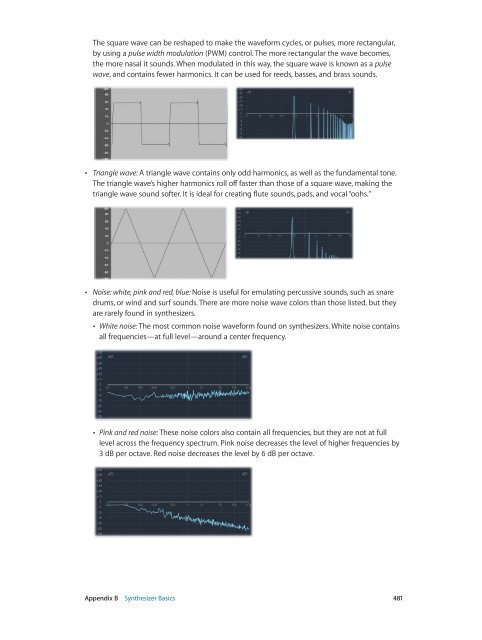Apple MainStage 3 Instruments - MainStage 3 Instruments
Apple MainStage 3 Instruments - MainStage 3 Instruments
Apple MainStage 3 Instruments - MainStage 3 Instruments
You also want an ePaper? Increase the reach of your titles
YUMPU automatically turns print PDFs into web optimized ePapers that Google loves.
The square wave can be reshaped to make the waveform cycles, or pulses, more rectangular,<br />
by using a pulse width modulation (PWM) control. The more rectangular the wave becomes,<br />
the more nasal it sounds. When modulated in this way, the square wave is known as a pulse<br />
wave, and contains fewer harmonics. It can be used for reeds, basses, and brass sounds.<br />
••<br />
Triangle wave: A triangle wave contains only odd harmonics, as well as the fundamental tone.<br />
The triangle wave’s higher harmonics roll off faster than those of a square wave, making the<br />
triangle wave sound softer. It is ideal for creating flute sounds, pads, and vocal “oohs.”<br />
••<br />
Noise: white, pink and red, blue: Noise is useful for emulating percussive sounds, such as snare<br />
drums, or wind and surf sounds. There are more noise wave colors than those listed, but they<br />
are rarely found in synthesizers.<br />
••<br />
White noise: The most common noise waveform found on synthesizers. White noise contains<br />
all frequencies—at full level—around a center frequency.<br />
• • Pink and red noise: These noise colors also contain all frequencies, but they are not at full<br />
level across the frequency spectrum. Pink noise decreases the level of higher frequencies by<br />
3 dB per octave. Red noise decreases the level by 6 dB per octave.<br />
Appendix B Synthesizer Basics 481
















